Last Updated on January 13, 2024 by Greg Gillson
I’ve put this resource together for you to answer your question: What birds are in my backyard in Colorado?
This article lists and discusses the identification of the most common birds in your backyard. The birds chosen in this article are compiled from actual data from the citizen science program eBird. Thus, it is more accurate than some other similar articles you may find on the web. I provide pictures of each bird species mentioned and I’ll tell how to attract them to your backyard.
These are the most common backyard birds in Colorado:
- American Robin
- House Finch
- Northern Flicker
- Dark-eyed Junco
- Black-billed Magpie
- Black-capped Chickadee
- Red-winged Blackbird
- American Crow
- European Starling
- Eurasian Collared-Dove
- Mourning Dove
- Blue Jay
- Song Sparrow
- American Goldfinch
- Western Meadowlark
- House Sparrow
- Downy Woodpecker
- Common Grackle
- Barn Swallow
- Mountain Chickadee
- White-breasted Nuthatch
- Broad-tailed Hummingbird
- House Wren
- Violet-green Swallow
- Western Wood-Pewee
- Western Kingbird
Colorado Birds and Birding in Colorado State
eBird lists over 515 types of birds as occurring in the state of Colorado.
The most common bird in Colorado: the most frequently seen bird in the state is American Robin. It is reported on 38% of bird watching lists.
If you are serious about knowing the birds native to Colorado, then check out eBird for Colorado. It has recent sightings and photos, illustrated checklists with weekly abundance bar charts for state, counties, and individual hotspots of the best birding locations.
If you want to know about other people interested in birds in your area, join a local bird group. The American Birding Association maintains a list of bird watching clubs for each state.
Colorado Bird Identification
This section is the species accounts. These are designed to help you to recognize birds you see in your backyard. I have used eBird to select the birds that are most common. “Common” means the birds seen most often throughout the year, not necessarily the most numerous.
Each species account starts with a photograph. In the identification section I am using size and shape and bill type before considering the color or patterns on the birds. I find these more reliable when trying to identify an unknown bird. Pay attention to body and tail shape and especially bill shape of birds you see, not just plumage color.
In the section on bird feeders and foods I tell how to attract each species. Not all types of backyard birds will come to feeders. But all backyard birds can be attracted with water. So don’t forget to add a birdbath to your bird feeding station.
Do you live in Western Colorado? Eastern Colorado? Northern Colorado? Southern Colorado? In the Front Range? In Southwestern Colorado?
To appear in this article, most birds are widely distributed throughout the state and are often year-round residents. However, for those birds that are more localized in place or time, I list the general region and seasonality. Please see the section following these species accounts for the lists of common species by season.
Even if a species is found in a general area, they occur only in the habitat they prefer. So, the exact habitat of your neighborhood is important for the presence of absence of certain kinds of birds.
1. American Robin (Turdus migratorius)
This familiar bird is a resident in the northern half of the United States and a winter visitor in the southern half.
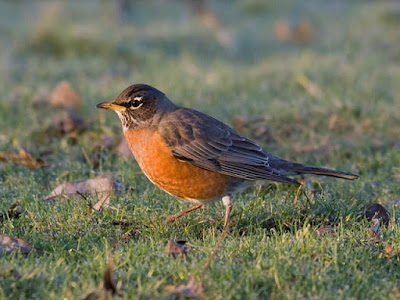 |
| American Robin. Greg Gillson. |
Range in Colorado: American Robins are year-round residents throughout Colorado.
Identification: This is a key species for comparing with an unknown bird.
Size: 10 inches long from bill tip to tail tip. About the same size as a Blue Jay or one of the Scrub-Jays. Larger than Red-winged Blackbird. Smaller than a Mourning Dove.
Shape: Very plump with a fairly long tail.
Bill: Straight and fairly slender, curved at the tip.
Color: Gray-brown upperparts, rusty orange breast.
Habitat, range & behavior: Open woodlands, farmlands, urban parks and lawns.
Migratory, breeds north across Alaska and Canada. Resident in most of the United States (lower 48). Winters in the United States, Mexico, to central America.
Hops on your lawn turning head this way and that looking for food. Their caroling song is one of the early signs of spring in the north.
Food and feeder preference: American Robins eat earthworms and other invertebrates in the lawn. May eat fruit from a tray feeder or the ground. Eat small berries from trees and bushes.
2. House Finch (Haemorhous mexicanus)
These are one of the most common backyard birds in the United States. There are other red finches, but these are the ones most likely in residential areas.
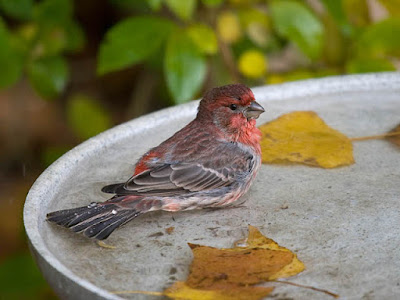 |
| House Finch. Greg Gillson. |
Range in Colorado: House Finches are year-round residents throughout most of Colorado, absent in far northeastern Colorado.
Identification: This is a key species for comparing with an unknown bird.
Size: About 6 inches from bill tip to tail tip. Larger than goldfinches and chickadees. Smaller than a White-crowned Sparrows or Spotted/Eastern towhees.
Shape: Medium build with a medium-long notched tail. Round head.
Bill: Short, conical.
Color: Brown and gray above with streaks on the sides of the pale underparts. Males with red (sometimes orange or rarely yellow) crown, chest, rump.
Habitat, range & behavior: You’ll find small flocks on wires, in short treetops and in bushes. Originally deserts and grasslands. Rural areas and towns are where they’re now most common.
Formerly found in the western United States and Mexico. Then introduced into the northeastern United States, but now found in nearly all of the lower-48 states and extreme southern Canada. Rare in plains states (Dakotas to Texas) and southern Florida.
House Finches are not territorial, but males sing throughout the year–a lively, wiry song ending in a couple of buzzy notes.
Food and feeder preference: House Finches love sunflower seeds and tube feeders. May eat from thistle socks.
You may like my in-depth article on attracting House Finches.
3. Northern Flicker (Colaptes auratus)
This ant-eating woodpecker spends a lot of time hopping and probing on the ground. This behavior confuses many beginners who don’t know what to make of the long bill, red wing linings, and white rump. When the males drum loudly on their downspouts at dawn in spring, then they know it’s a woodpecker!
 |
| Northern (Red-shafted) Flicker. Greg Gillson. |
Range in Colorado: Northern Flickers are year-round residents throughout Colorado.
Identification:
Size: About the size of a Mourning Dove. Larger than a robin.
Shape: Stocky with short legs, short tail, big head.
Bill: As long as head, thin, slightly curved.
Color: Back is brown with black bars. Under parts pinkish with black spots. Undersides of black wing and tail feathers are bright salmon red (West) or yellow (East). Head gray (West) or brown (East) and males with red (West) or black (East) whisker marks and nape marks (East). Black crescent across chest. White rump seen in flight.
Habitat, range & behavior: Found in woodland edges and forests.
Year-round resident from extreme southern Canada, across all of the lower-48 states and in the mountains of Mexico and Middle America. In summer breeds northward well into Canada and Alaska.
Frequently noted hopping on ground pecking in the ground for insects. In late spring, males proclaim their territory by rapid pounding on a hollow tree branch, though the ringing of metal downspouts at dawn is louder and carries much farther, to the exasperation of anyone trying to sleep inside!
Food and feeder preference: Ants and beetles are their primary foods. Will eat black oil sunflower seeds and are attracted to suet.
4. Dark-eyed Junco (Junco hyemalis)
Colloquially called “snowbirds,” they often arrive in backyards in winter from nearby mountain forests or more northern climes.
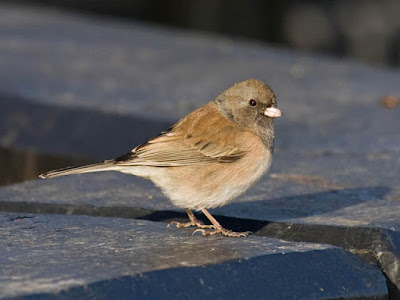 |
| Dark-eyed Junco. Photo by Greg Gillson. |
Range in Colorado: Dark-eyed Juncos are year-round residents throughout most of Colorado, winter visitors only in far southeastern Colorado.
Identification:
Size: Small birds about the size of a House Finch.
Shape: Round body, short neck, round head, fairly long square-ended tail.
Bill: Short, pointed, conical, pink.
Color: Eastern birds are a darker all-gray with white belly. Western birds (those breeding in California and pictured above) have jet black hood over their head, brown back, white belly and pink sides. Females paler.
Habitat, range & behavior: Breed in coniferous forests. Winters widely. Avoids heavy brush, preferring widely spaced bushes.
Breeds across most of Canada, Alaska, and the western half of the United States. Winters from southern Canada and all of the lower 48-states to extreme northern Mexico.
Spend much of their time hopping and feeding on the ground.
Food and feeder preference: Dark-eyed Juncos eat mostly seeds, also insects in summer. Readily feed at backyard feeders on mixed seeds on hopper or tray feeders and ground.
You may like my in-depth article on attracting Dark-eyed Juncos.
5. Black-billed Magpie (Pica hudsonia)
This large flashy bird with a long tail is a ranchland bird in the West. The only similar bird in North America is the Yellow-billed Magpie of the Central Valley of California.
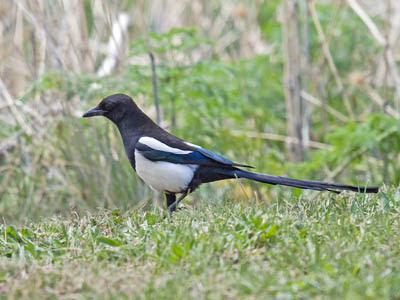 |
| Black-billed Magpie. Greg Gillson. |
Range in Colorado: Black-billed Magpies are year-round residents throughout most of Colorado, winter visitors only in southeastern Colorado.
Identification:
Size: About the size of an American Crow, but with a longer tail.
Shape: Thick neck, large head, strong legs. A very long pointed tail: the distance from the base of the tail to the tip of the tail is nearly as long as from the base of the tail to the tip of the bill. Wings are broad and rounded at the tips.
Bill: Stout, nearly as long as head.
Color: Black head, breast, back. White shoulders and belly. Wings black above with bluish or greenish sheen; most of the primaries are white. Tails is blackish with an iridescent blue-green sheen.
Habitat, range & behavior: Magpies are found in dry open country, ranches, farms, scattered open pine lands and riparian thickets.
They are residents from southern Alaska to the Great Basin and Great Plains to the Dakotas and south to New Mexico.
Fly with slow wing beats and deep wing strokes displaying large white wing patches. Social. Perch on fence posts. Forage on ground. Calls are noisy, raspy, querulous “yak?”
Food and feeder preference: Omnivore as crows, eating carrion, berries, seeds, nuts, human garbage, pet food. Birders generally don’t want this species at their bird feeders. Locals often view these birds as pests.
6. Black-capped Chickadee (Poecile atricapillus)
This is a common backyard bird in the northern half of the United States.
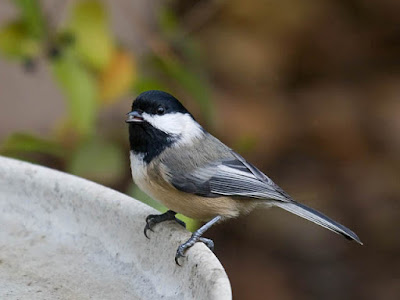 |
| Black-capped Chickadee. Greg Gillson |
Range in Colorado: Black-capped Chickadees are year-round residents throughout Colorado.
Identification:
Size: Chickadees are small birds, the same general size as an American Goldfinch.
Shape: Round body, big round head, long tail with rounded tip.
Bill: Short, straight, stout.
Color: Gray above, buffy below. Black cap and bib with white lower face. White edges on wing feathers.
Habitat, range & behavior: Deciduous and mixed forests.
They range from the northern half of the United States, southern half of Canada, and most of Alaska.
Small flocks flit actively from tree to tree acrobatically gleaning insects from twig tips. In winter chickadees make up the core of mixed-species flocks also containing nuthatches, kinglets, creepers, woodpeckers and others.
Food and feeder preference: Seeds, insects, berries. They eat at tube, hopper and tray feeders. They love black oil sunflower seeds and suet.
You may like my in-depth article on attracting Black-capped Chickadees.
7. Red-winged Blackbird (Agelaius phoeniceus)
These noisy flocking birds are most often found in marshes. But in winter they are found in backyards.
 |
| Male Red-winged Blackbird. Greg Gillson. |
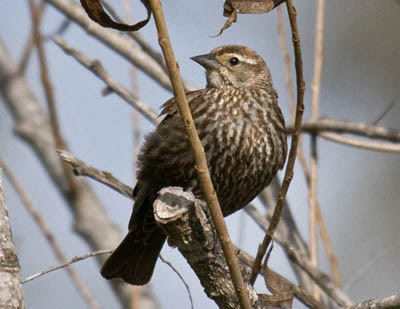 |
| Female Red-winged Blackbird. Greg Gillson. |
Range in Colorado: Red-winged Blackbirds are year-round residents throughout Colorado.
Identification: This is a key species for comparing with an unknown bird.
Size: About 8-3/4 inches long from bill tip to tail tip. About the size of a Northern Cardinal. Smaller than an American Robin.
Shape: Pot-bellied with a longer bill and flat forehead. Tail average.
Bill: Long and sharp pointed.
Color: Males are black with red and yellow shoulder patch. Females are streaked brown and rusty (sparrow-like but pointed bill and flat forehead).
Habitat, range, and behavior: Cattail marshes and wetlands are their summer habitat. In winter they feed in grain fields.
They breed across most of the North American continent. In winter they withdraw from most of Alaska and Canada.
They are found in colonies in summer and large flocks in winter.
Food and feeder preference: They eat insects in summer. In winter they eat grain and seeds. They visit feeders, more often in large winter flocks, and eat most seeds and suet.
8. American Crow (Corvus brachyrhynchos)
This larger all-black bird is common in cities and country. Its cawing call is familiar to most people.
 |
| American Crow. Greg Gillson. |
Range in Colorado: American Crows are year-round residents throughout Colorado.
Identification: This is a key species for comparing with an unknown bird.
Size: About 17-1/2 inches long from bill tip to tail tip, though there is much size variation throughout its range. Larger than blackbirds and grackles. Smaller than ravens.
Shape: Thick neck, large head, rather short square-ended tail. Longer legs. In flight has rounded wing tips with each primary feather separated from others forming “fingers.”
Bill: As long as head, thick, black.
Color: Glossy black throughout.
Habitat, range & behavior: They prefer open areas with trees, fields, farms, cities.
They are common across most of the United States lower-48, except in the desert southwest. They move into southern Canada in summer.
They gather in evening communal roosts in large flocks that may number into the thousands and then move out at dawn into the surrounding area.
Food and feeder preference: Omnivorous, American Crows feed on large insects, grain, small mammals, carrion. You probably don’t want these large entirely black birds in your backyard feeders. So don’t feed table scraps to birds.
9. European Starling (Sturnus vulgaris)
Introduced to North America in the late 1800’s, they crossed the continent, often to the detriment of native cavity-nesting birds. The prime example of an invasive species.
 |
| European Starling. Greg Gillson. |
Range in Colorado: European Starlings are year-round residents throughout Colorado.
Identification:
Size: About the size of a Red-winged Blackbird. Smaller than an American Robin. Larger than a White-crowned Sparrow or Spotted/Eastern towhee.
Shape: Stocky with large head, short square-ended tail. Longer legs.
Bill: As long as head. Sharp pointed. Yellow in spring, otherwise dark.
Color: They are grayish brown much of the year, with glossy iridescence and white spotting during the spring.
Habitat, range & behavior: Lowland birds that need trees large enough for nest cavities but plenty of open area for feeding. They are most abundant in urban and suburban areas where they find food and artificial nest cavities.
Resident from coast-to-coast from southern Canada to northern Mexico. In summer north across Canada and Alaska. Native range is Europe to Pakistan, north Africa.
Often viewed as a pest, starlings often bully other backyard birds, taking over bird feeders, and stealing nest cavities from smaller native birds.
In winter they can form into flocks of tens of thousands.
Food and feeder preference: European Starlings eat primarily insects when available, often feeding on the ground. Discourage them from your backyard hopper and tray feeders by never feeding birds table scraps (including bread or meat). They have weak feet and do not perch well on tube feeders. A cage mesh around smaller hopper feeders may keep them out.
10. Eurasian Collared-Dove (Streptopelia decaocto)
These large pale pigeons have only been in the United States since invading Florida in 1983. But they have taken over much of the continent.
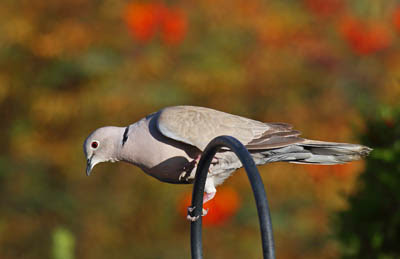 |
| Eurasian Collared-Dove. Greg Gillson. |
Range in Colorado: Eurasian Collared-Doves are year-round residents throughout Colorado.
Identification:
Size: Large pigeon. Larger than Mourning Dove. Same size as domestic pigeon.
Shape: Full plump breast. Round head. Long square tail.
Bill: Small and dainty.
Color: Cream-colored, may be slightly warmer brown on back or, conversely, may be nearly white. Black hind neck mark. Broad white band at end of tail. From underneath when perched on wire, note the black base to the underside of the tail.
Habitat, range & behavior: These pigeons are found in residential areas and farmlands. Look for them perched on electric lines or in trees.
They are year-round residents in residential areas throughout almost all of the United States, except rare in the Northeast.
A pair of birds nests in one area nearly year-round, then builds in numbers over a couple of years. Then several birds from the group fly up to 500 miles and set up a new colony. In this way this species took over much of Europe in the last century, and most of North America, starting from Florida in 1983 (from birds escaped from or vagrant in Bahamas).
Food and feeder preference: Eat grain. Will eat all seeds at bird feeders. Large, hungry, and often visit feeders in groups.
11. Mourning Dove (Zenaida macroura)
Mourning Doves are the most widespread and most frequent backyard bird in the Lower 48 states of the United States.
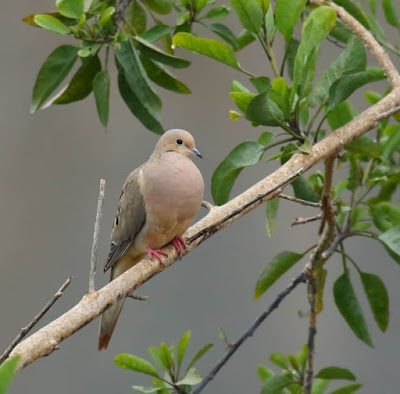 |
| Mourning Dove. Greg Gillson. |
Range in Colorado: Mourning Doves are year-round residents throughout Colorado.
Identification: This is a key species for comparing with an unknown bird.
Size: About 12 inches long from bill tip to tail tip. About same size as Northern Flicker. Larger than American Robin. Slightly smaller than domestic city pigeon.
Shape: Very plump with a small round head. Tail is long and pointed. Legs are short.
Bill: Small and rather slender.
Color: Pale brown-pink body, darker wings and tail. White edges on side of tail.
Habitat, range & behavior: Semi-open areas such as urban areas, farmlands, woods. Often seen perched on wires, fences.
It is a resident across the lower-48 states and Mexico, with some movement out of northern areas in winter.
Their mournful cooing is a familiar spring birdsong.
Food and feeder preference: Mourning Doves eat seeds almost exclusively. Attract with black oil sunflower seeds on a large sturdy tray feeder or on the ground.
12. Blue Jay (Cyanocitta cristata)
A common and well-known bird in the eastern half of the United States.
 |
| Blue Jay. skeeze from Pixabay |
Range in Colorado: Blue Jays are year-round residents in northeastern Colorado, winter visitors only in southeastern Colorado, absent in central and western Colorado.
Identification:
Size: About that of American Robin.
Shape: Fluffy, large crested head, ample tail. Large strong legs.
Bill: Black, long and stout.
Color: Blue above, white below. Black neck collar. White patches in wing.
Habitat, range & behavior: Woodlands and towns in the eastern half of the United States. In summer into southern Canada.
Bold and brash. May bully smaller birds. Jays gulp lots of seeds or other food at once, storing it in their crop. Then they fly off and bury food items in a hidden cache.
Food and feeder preference: Omnivorous. They can quickly empty your feeder! Because they are also aggressive toward other feeder birds, some people put mesh cages around smaller bird feeders. Small birds can go through, squirrels and larger “pest” birds are prevented entry. Some people feed jays peanuts, perhaps away from the seed feeders.
13. Song Sparrow (Melospiza melodia)
A common bird, but variable, and similar to many other streaked brown sparrows.
 |
| Song Sparrow. Greg Gillson. |
Range in Colorado: Song Sparrows are year-round residents in central and western Colorado, winter visitors only in eastern Colorado.
Identification:
Size: A smaller bird, similar in size to House Finch and juncos. Larger than chickadees and goldfinches. Smaller than White-crowned Sparrows or Spotted/Eastern towhees.
Shape: Plump with round head, long rounded tail.
Bill: Short, conical.
Color: Highly variable in darkness and color saturation across its range (dark rusty to pale gray). Generally gray-brown above with dark brown streaking on back. Complicated head pattern. Streaking on sides and breast converge into dense central breast spot.
Habitat, range & behavior: Thickets, especially near water. Backyard shrubbery.
Resident in western United States, western Canada, coastal southern Alaska, northeastern US. In summer also moves into mid-Canada and northern half of US. In the winter found in most of the US lower-48. Also, a population in central Mexico.
Forages on ground, never far from low cover to which they fly if startled.
Food and feeder preference: Song Sparrows feed on seeds and insects near the ground. Will visit hopper and tray feeders for mixed bird seed.
14. American Goldfinch (Spinus tristis)
A beautiful tiny finch familiar to many in its bright yellow summer plumage. Colloquially called a “wild canary.”
 |
| American Goldfinch. Greg Gillson |
Range in Colorado: American Goldfinches are winter visitors throughout Colorado, year-round residents in northeastern Colorado,
Identification: This is a key species for comparing with an unknown bird.
Size: Very small at about 5 inches from bill tip to tail tip. Similar in size to a chickadee. Larger than hummingbirds. Smaller than juncos and House Finches.
Shape: Tiny, somewhat plump with larger head and short tail.
Bill: Short, conical, pink.
Color: Males in summer are bright lemon yellow with black forehead and black wings and tail with white bars. White under tail coverts. Females are dull olive, wings and tail browner. Winter birds are pale grayish-yellow with tan and brown wings and tail.
Habitat, range & behavior: This species is found in weedy fields and similar clearings with thistles and similar plants.
It is found coast-to-coast throughout the year across most of the middle lower-48 states. In summer moves north to the Canada border. In the winter found south to the Mexico border.
The flight is highly undulating, rising and falling as they flap in short bursts.
Besides a long, sweet lilting song, they call in flight a lilting 4-part: “potato chip!”
Food and feeder preference: Feeds on weed seeds, thistle seed. May eat black oil sunflower seeds from tube feeder. Love Nyjer seed in a feeder called a “thistle sock.”
You may like my in-depth article on attracting American Goldfinches.
15. Western Meadowlark (Sturnella neglecta)
These are beautiful songsters of the prairie grasslands.
 |
| Western Meadowlark. Greg Gillson. |
Range in Colorado: Western Meadowlarks are year-round residents throughout most of Colorado, summer residents only in northwestern Colorado.
Identification:
Size: Bigger than a European Starling, smaller than an American Robin.
Shape: Stocky and pot-bellied, with short tail and flat forehead profile.
Bill: Long, straight, and sharp pointed.
Color: Straw and brown-colored upper parts. Bright yellow below with black necklace. White outer tail feathers. Duller in winter.
Habitat, range, & behavior: Fields, pastures, prairies.
The summer across the West from the Great Lakes to the Pacific, and western Canada to western Texas, and into Mexico. Move out of Canada in winter and spread to Gulf Coast.
Forage on fields and bare grounds, often found with cattle. In flocks in winter.
Foods and feeder preference: Grain and insects. They do not come to feeders.
16. House Sparrow (Passer domesticus)
Like the starling, this is another bird introduced from Europe in the 1800’s. This sparrow is commonly found in cities and farmlands. It is considered a pest in most areas where it has been introduced.
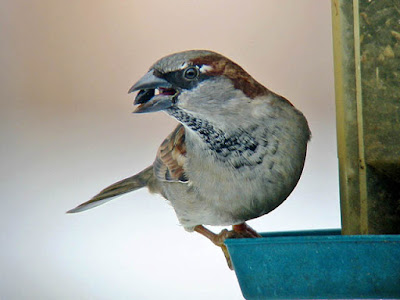 |
| House Sparrow. Greg Gillson |
Range in Colorado: House Sparrows are year-round residents throughout Colorado.
Identification:
Size: The size of a House Finch or Dark-eyed Junco.
Shape: Chunkier than native North American sparrows with large head, barrel chest, short neck, medium tail, short legs.
Bill: Short, conical.
Color: Males are brown and gray with a black mask. Females lack the black and are tan and brown with a pale line back from the eye.
Habitat, range & behavior: Cities and farms.
Range in North American from southern Canada through Central America. In summer northward through Canada to southern Alaska. Originated in Middle East and spread to most of Europe and Asia. Introduced in South America, Africa, Australia–nearly anywhere there are people and cities.
They tend to be messy… and have a good appetite and may occur in large noisy chirping flocks. They are aggressive toward other feeder birds.
Food and feeder preference: They eat grain, seed, and insects. To discourage them from your hopper and tray feeders do not feed birds human food scraps. They have a bit of difficulty eating from tube feeders.
17. Downy Woodpecker (Dryobates pubescens)
This tiny woodpecker is found across the United States.
 |
| Downy Woodpecker. Greg Gillson |
Range in Colorado: Downy Woodpeckers are year-round residents throughout Colorado.
Identification:
Size: Bigger than a junco or House Finch. Smaller than a Red-winged Blackbird. About the same size as a White-crowned Sparrow, but with a much shorter tail.
Shape: Stocky with large head and short stiff tail.
Bill: Short, chisel shaped.
Color: Black-and-white striped head. Black wings with white spots. Solid white back. White under parts. Black tail with white outer tail feathers with black bars or spots. Male with small red spot at back of head.
Habitat, range & behavior: Found in small deciduous trees, willows, and even weed stocks such as teasel, especially near water.
Ranges coast-to-coast across all but northernmost parts of Canada and Alaska south to the southern US. Absent in the desert southwest.
Interestingly, I learned today that the males may more often be found in smaller plants and twigs, while females are more likely on tree trunks.
Food and feeder preference: Insects, fruits, and seeds. Gleans arthropods from the bark of trees. Attract with suet feeder. Will also eat black oil sunflower seeds.
18. Common Grackle (Quiscalus quiscula)
Sometimes considered a pest to crops, grackles are longer and lankier than very similar blackbirds.
 |
| Common Grackle. GeorgiaLens from Pixabay |
Range in Colorado: Common Grackles are summer residents throughout most of Colorado, absent in southwestern Colorado.
Identification:
Size: Larger than Red-winged Blackbirds, they are near the length of Mourning Doves.
Shape: Long, with long full keel-shaped tail, long legs, flat crown.
Bill: Longer than head, pointed, but stouter than other blackbirds.
Color: Glossy black with hint of bronze or green on head (depending upon population). Yellow eye.
Habitat, range & behavior: They are found in agricultural areas, woodland edges, city parks and lawns.
Resident in the southeastern United States. In summer they migrate northward and west to the central United States and Canada.
They monopolize feeders and are bullies toward other birds.
Food and feeder preference: Grain, corn, acorns, small aquatic fish and amphibians. To discourage them, use tube feeders, rather than hopper or tray feeders. Don’t over-feed, keep spilled seed picked up.
19. Barn Swallow (Hirundo rustica)
These swallows are widely distributed throughout the world, primarily breeding in the northern hemisphere, and wintering in the mid-latitudes and southern hemisphere.
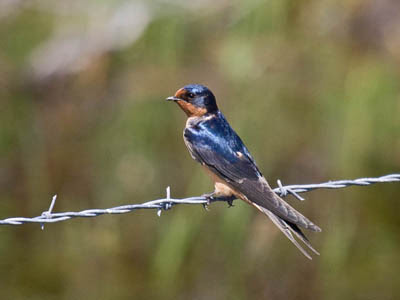 |
| Barn Swallow. Greg Gillson. |
Range in Colorado: Barn Swallows are summer residents throughout Colorado.
Identification:
Size: About the size of a House Finch but with a much longer tail.
Shape: Stocky, short necked but with long body and tail. Tail is forked, with very long outer tail feathers. Wings pointed.
Bill: Short, wide.
Color: Glossy dark purplish-blue above. Pinkish-orange below.
Habitat, range & behavior: Barn Swallows live in open country, frequently near humans. Farmlands. Nest in barns, under small bridges.
In North America breed from Mexico to northern Canada and Alaska, wintering from southern Mexico throughout most of South America.
Frequently seen swooping low over the ground hunting flying insects. Perch on wires, fences. Voice is twitters and chirps with grating sounds.
Food and feeder preference: Eat flying insects on the wing and are not attracted to backyard feeders.
20. Mountain Chickadee (Poecile gambelli)
These chickadees are found in mountain forests of the West.
 |
| Mountain Chickadee. Greg Gillson. |
Range in Colorado: Mountain Chickadees are year-round residents in western and south-central Colorado, absent in eastern Colorado.
Identification:
Size: Small birds, smaller than finches and sparrows.
Shape: Round fluffy body. Large round head. Long penduline tail. Strong legs and feet.
Bill: Short and stout.
Color: Gray with black crown and throat. White eyebrow line.
Habitat, range, & behavior: Found in mountain pine forests.
Western Canada and the United States in pine forests at high elevations.
Feed in small straggling flocks. Acrobatically hang from tips of twigs to feed.
Food and feeder preference: Beetles and other insects, seeds. Readily come to hopper feeders for black oil sunflower seeds.
21. White-breasted Nuthatch (Sitta carolinensis)
A favorite feeder bird for many for its active antics and fearlessness. Though a small bird it is the largest nuthatch in North America.
 |
| White-breasted Nuthatch. Greg Gillson |
Range in Colorado: White-breasted Nuthatches are year-round residents throughout Colorado.
Identification:
Size: About chickadee-sized in length. Smaller than a junco or House Finch.
Shape: Appears large-headed, neckless, very short tailed. Short legs.
Bill: Nearly as long as head, straight, thin.
Color: Blue-gray above, white below. Black cap, wing tips, tail. Rusty feathers under tail.
Habitat, range & behavior: Common in oak and oak-pine woodlands, wooded towns.
Found across the United States, southern Canada, mountains of central Mexico. Absent from treeless grasslands, deserts in the west.
Crawls over tree branches and head-first down tree trunks searching for insects.
Food and feeder preference: Insects, seeds, acorns and other nuts. Love black oil sunflower seeds feeding on hopper and tray feeders. Suet blocks.
22. Broad-tailed Hummingbird (Selasphorus platycercus)
These hummingbirds of the mountain West have rosy-red throats.
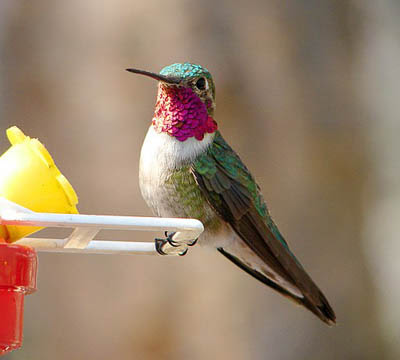 |
| Broad-tailed Hummingbird. Michelle Lynn Reynolds. CC BY-SA 3.0 |
Range in Colorado: Broad-billed Hummingbirds are summer residents in higher mountains of western Colorado.
Identification:
Size: Tiny. Hummingbirds are the smallest of birds. Much smaller than a goldfinch.
Shape: Pudgy with a round head and long wings.
Bill: Long, thin and tubular.
Color: Metallic green above, white below. Males with metallic red throat.
Habitat, range & behavior: Mountain meadows.
Breed in mountains of the western United States, winter in Mexico.
The visit lowland hummingbird feeders in spring and early fall during migration.
Food and feeder preference: Feed on insects and flower nectar. Visit hummingbird feeders.
23. House Wren (Troglodytes aedon)
These birds will readily use nest boxes to raise their young.
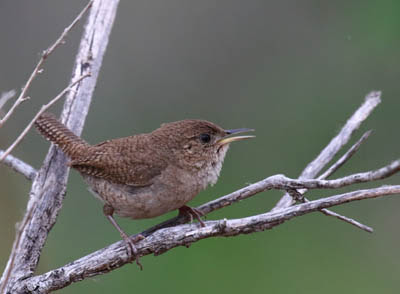 |
| House Wren. Greg Gillson. |
Range in Colorado: House Wrens are summer residents throughout Colorado.
Identification:
Size: About the size of Black-capped Chickadee but with shorter tail.
Shape: Round body. Large head. Thin short tail.
Bill: Fairly long, thin, slightly down curved. Sharply pointed.
Color: Rather dull brownish gray throughout. Paler throat and breast. Tail barred with black and pale bars along with the brown.
Habitat, range & behavior: Brushy areas, woodland edges, hedge rows, tree stumps in logged areas.
Breed across Canada and the northern and mid-latitudes of the United States. Winter to the southern United States and through Mexico. Found year round at southern edge of breeding range: California, North Carolina to northern Alabama, southern Arizona south through mountains of Mexico.
Stay hidden in brushy areas. Hop among tree roots, logged stumps.
Food and feeder preference: May feed at suet feeder.
24. Violet-green Swallow (Tachycineta thalassina)
This common bird may be found nesting in bird houses or other holes in buildings or backyard trees.
 |
| Violet-green Swallow. Greg Gillson. |
Range in Colorado: Violet-green Swallows are summer residents throughout most of Colorado, absent in far eastern Colorado.
Identification:
Size: About the size of American Goldfinches, but with longer wings.
Shape: Round head, thicker chest and long thin body. Very short tail. Long pointed wings.
Bill: Very short and wide.
Color: Lime green upper back, violet lower back. White sides to rump. Black wings and tail. White underparts and face that nearly encircles eyes.
Habitat, range & behavior: Open skies above forests and residential areas.
Summers from Alaska, western Canada, and the western US and Mexico. Winters in southern Mexico.
Food and feeder preference: Flying insects caught on the wing. Do not come to bird feeders but will use bird houses.
25. Western Wood-Pewee (Contopus sordidulus)
These birds sing their burry pee-wee, pee-year song into summer and throughout the day.
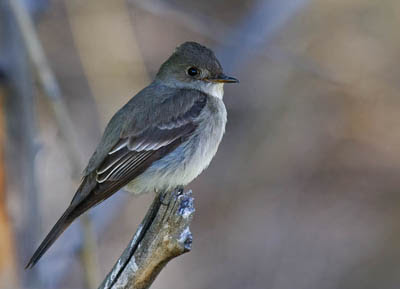 |
| Western Wood-Pewee. Greg Gillson. |
Range in Colorado: Western Wood-Pewees are summer residents throughout Colorado.
Identification:
Size: Just slightly bigger than a House Finch.
Shape: Large head and big chest, long wings and tail. Upright posture.
Bill: Medium length compared to head, but wide at base and flat. Mostly dark, with a touch of yellow-orange at base of lower mandible.
Color: A dull gray-green-brown. Two broad pale wing bars. Under parts pale with grayish sides, often show yellow on the belly when in shade.
Habitat, range & behavior: A bird of open woodlands.
Summer resident from Alaska, western Canada, western United States and into Mexico. Winters in South America.
These larger flycatchers sit motionless on tip of dead branch, then fly out to snap up a flying insect, then return to their original perch again.
Food and feeder preference: Feed on flying insects. Do not come to feeders.
26. Western Kingbird (Tyrannus verticalis)
You may note these birds aggressively and noisily chasing off other birds, such as crows and hawks, from their territories. And other interloping Western Kingbirds, of course.
 |
| Western Kingbird. Greg Gillson. |
Range in Colorado: Western Kingbirds are summer residents throughout Colorado.
Identification:
Size: Larger than phoebes. Smaller than American Robins. The same size as Red-winged Blackbirds.
Shape: Long body with heavy chest. Large head with raised hind crown. Large bill. Long full tail. Upright posture.
Bill: Fairly long, but shorter than head, stout and wide at the base.
Color: Gray head, back, and chest. Yellow belly. Brown wings. Black tail with contrasting white outer tail feathers.
Habitat, range & behavior: Open country.
Summers in the western half of the United States and adjacent southern Canada.
Perches on electric wires, fence lines. Chases flying insects and returns to perch.
Food and feeder preference: Feeds on flying insects. Does not come to feeders.
Common Birds in Colorado
To determine how common each species is I used the data from actual bird sightings from the citizen science program eBird. Birds are listed by frequency. That is, how often the species is recorded on checklists submitted to eBird (a percentage).
When choosing the birds to include in this article I leaned strongly to birds that are present throughout the year in good numbers. Thus, many of the common birds are year-round residents. This means that they live in the same location all year. They raise their young in your neighborhood. They don’t migrate. Or if the species does migrate, the ones living in your area don’t. If this is the case, some migrants may move into your area during certain times of year, adding to the same species that are in your yard full time.
Some migrant birds visit your yard during the “summer.” Often, they arrive in spring and remain until late fall. They nest and raise their young in your neighborhood. These are the summer residents.
Other migrant birds visit your backyard during the “winter.” Some of these winter visitors may arrive in July and remain into April. Others may only be found in the cold of December or January. They key here is that they nest and raise their young somewhere else. They only visit your yard in the non-breeding season.
Migration is an amazing spectacle.
There will be birds that fly through your region in spring or fall (or both). They may visit your backyard only a few days or weeks a year. They aren’t regular enough, or stay long enough, to be included in this article. But the number of briefly visiting migrant birds could double the number of species presented here. You may see them over time. Consult checklists in eBird for your county to see what is possible.
I have generally excluded common waterfowl, birds of prey, shorebirds, seabirds, and others that aren’t usually found in residential areas. But they may certainly fly over or be seen regularly if your home is on a shoreline, for instance.
Most common backyard birds in Colorado throughout the year
The following list is the backyard birds that are, on average, most common throughout the entire year. The list is ordered by most common based on the frequency of how often each species is recorded on checklists submitted to eBird.
- American Robin (38% frequency)
- House Finch (35%)
- Northern Flicker (35%)
- Dark-eyed Junco (35%)
- Black-billed Magpie (30%)
- Black-capped Chickadee (29%)
- Red-winged Blackbird (29%)
- American Crow (26%)
- European Starling (23%)
- Eurasian Collared-Dove (22%)
- Mourning Dove (21%)
- Blue Jay (18%)
- Song Sparrow (16%)
- American Goldfinch (16%)
- Western Meadowlark (16%)
- House Sparrow (15%)
- Downy Woodpecker (14%)
- Common Grackle (13%)
- Barn Swallow (13%)
- Mountain Chickadee (13%)
- White-breasted Nuthatch (13%)
Most common backyard birds in Colorado in winter
- Dark-eyed Junco (57% frequency)
- House Finch (38%)
- Black-capped Chickadee (35%)
- Northern Flicker (34%)
- Black-billed Magpie (33%)
- American Crow (29%)
- European Starling (23%)
- American Robin (22%)
- Eurasian Collared-Dove (22%)
- Red-winged Blackbird (18%)
- Downy Woodpecker (16%)
- Blue Jay (16%)
- House Sparrow (16%)
Most common backyard birds in Colorado in summer
- American Robin (51% frequency)
- Mourning Dove (34%)
- Broad-tailed Hummingbird (32%)
- Red-winged Blackbird (31%)
- House Finch (29%)
- Northern Flicker (29%)
- House Wren (28%)
- Black-billed Magpie (24%)
- Barn Swallow (23%)
- Violet-green Swallow (22%)
- American Crow (21%)
- Common Grackle (20%)
- Western Meadowlark (20%)
- Black-capped Chickadee (19%)
- Western Wood-Pewee (18%)
- Eurasian Collared-Dove (18%)
- Western Kingbird (18%)
How do birds differ between seasons?
Colorado has strong seasonal differences.
Birds found primarily in summer are Broad-tailed Hummingbirds, House Wrens, Barn Swallows, Violet-green Swallows, Western Wood-Pewees, and Western Kingbirds.
Red-winged Blackbirds are more common in summer than in winter.
Dark-eyed Juncos are more common in winter than in summer.
Common Backyard Birds of Denver, Colorado
- American Crow (45% frequency)
- House Finch (43%)
- Northern Flicker (41%)
- Black-capped Chickadee (40%)
- Dark-eyed Junco (38%)
- Rock Pigeon (29%) Learn about this species on eBird
- European Starling (29%)
- Black-billed Magpie (25%)
- House Sparrow (21%)
- American Robin (19%)
American Robins, Black-capped Chickadees, Red-winged Blackbirds are less common in Denver than in the state average as a whole.
American Crows, Rock Pigeons, European Starlings are more common in Denver than average for the state, as expected in an urban area.
Common Backyard Birds of Colorado Springs, Colorado
- Dark-eyed Junco (52% frequency)
- House Finch (48%)
- Northern Flicker (46%)
- American Robin (43%)
- Black-billed Magpie (38%)
- Black-capped Chickadee (34%)
- American Crow (33%)
- Spotted Towhee (31%) Learn about this species on eBird
- Eurasian Collared-Dove (29%)
- Blue Jay (25%)
- Mountain Chickadee (24%)
- Woodhouse’s Scruby-Jay (23%) Learn about this species on eBird
- Downy Woodpecker (23%)
- White-breasted Nuthatch (22%)
- European Starling (22%)
- Red-winged Blackbird (22%)
- Mourning Dove (22%)
- Rock Pigeon (20%) Learn about this species on eBird
Dark-eyed Juncos, House Finches, Northern Flickers, Black-billed Magpies, Spotted Towhees, Mountain Chickadees, Woodhouse’s Scrub-Jays, White-breasted Nuthatches are more common in Colorado Springs than the state average.
Red-winged Blackbirds are a bit less common in Colorado Springs than the state average.
Common Backyard Birds of Pueblo, Colorado
- American Robin (43% frequency)
- European Starling (40%)
- Northern Flicker (35%)
- Red-winged Blackbird (34%)
- House Finch (33%)
- Dark-eyed Junco (32%)
- Eurasian Collared-Dove (31%)
- Mourning Dove (26%)
- White-crowned Sparrow (26%) Learn about this species on eBird
- Yellow-rumped Warbler (26%) Learn about this species on eBird
- House Sparrow (23%)
- Common Grackle (22%)
- Blue Jay (21%)
- Barn Swallow (20%)
European Starlings, Eurasian Collared-Doves, White-crowned Sparrows, Yellow-rumped Warblers, House Sparrows, Common Grackles are more common in Pueblo than average for the state.
Black-billed Magpies, Black-capped Chickadees are less common in Pueblo than the state average.
Common Backyard Birds of Durango, Colorado
- American Robin (43% frequency)
- Black-billed Magpie (40%)
- Dark-eyed Junco (37%)
- House Finch (36%)
- Eurasian Collared-Dove (34%)
- Northern Flicker (29%)
- Black-capped Chickadee (28%)
- American Crow (27%)
- Red-winged Blackbird (27%)
- Woodhouse’s Scrub-Jay (26%) Learn about this species on eBird
- White-breasted Nuthatch (25%)
- Yellow-rumped Warbler (22%) Learn about this species on eBird
- European Starling (22%)
- Pine Siskin (22%) Learn about this species on eBird
- Mountain Chickadee (21%)
- Song Sparrow (20%)
Black-billed Magpies, Eurasian Collared-Doves, Woodhouse’s Scrub-Jays, White-breasted Nuthatches, Yellow-rumped Warblers, Pine Siskins, Mountain Chickadees are more common in Durango than in the state of Colorado as a whole.
Wrapping Up
Colorado boasts a diverse and vibrant array of birds, with both year-round residents and seasonal visitors gracing its landscapes. Here are some of the most common birds you might encounter across the state if you want to explore beyond your backyard:
Open Fields and Grasslands:
- Western Meadowlark: This state bird of Wyoming, often seen in Colorado, exhibits a bright yellow breast, black V-mark on its chest, and a long, melodious song. Look for them perched on fence posts or singing from open fields.
- Mourning Dove: These slender, gray birds with white underparts and mournful cooing calls are commonly seen foraging for seeds on the ground.
- American Goldfinch: During breeding season, these tiny birds transform into sunshine on wings, with bright yellow bodies, black caps, and black wing bars. You’ll find them in fields, meadows, and gardens.
Forests and Woodlands:
- Steller’s Jay: These bold and vocal birds showcase a stunning combination of blue, black, and white. They flash their long blue tails through forests and woodlands, adding a dash of personality to the scenery.
- Common Raven: These large, intelligent birds with black plumage and raspy calls are often seen soaring over mountains and forests. Keep an eye out for their acrobatic displays in the air.
- Dark-eyed Junco: These gray sparrows with white wing bars and pink beaks are common ground feeders in forested areas, readily hopping and foraging under trees.
Mountain Regions:
- Clark’s Nutcracker: These large, intelligent birds sport a striking black and white plumage with a bright blue patch on their wings. They frequent mountain forests and meadows, readily cracking nuts with their powerful beaks.
- Pinyon Jay: These social birds with blue wings and a gray body are found in pinyon-juniper woodlands, readily gathering in noisy flocks and cracking open pine nuts.
- Mountain Chickadee: Similar to the Black-capped Chickadee but with a chestnut brown back, these energetic birds frequent higher elevations in coniferous forests, readily visiting feeders.
Frequently Asked Questions
What is the state bird of Colorado?
There are actually two state birds in Colorado, depending on the context:
- Official State Bird: The Lark Bunting (Calamospiza melanocorys) was designated as the official state bird of Colorado in 1931. These small, black-and-white buntings breed in the state’s grasslands and plains during the summer months before migrating south for the winter.
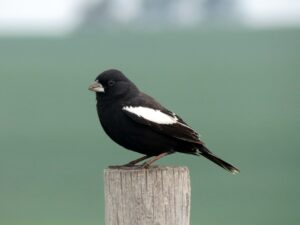
- State Songbird: The American Robin (Turdus migratorius) was not officially designated as a state bird but is often referred to as the “state songbird” of Colorado due to its widespread presence and popularity. These familiar red-breasted birds are year-round residents in the state and are readily found in backyards, parks, and other open spaces.
So, while the Lark Bunting holds the official title of state bird, the American Robin also holds a special place in the hearts of Coloradans and is often associated with the state’s landscapes and wildlife.
What bird has a black head and blue body in Colorado?
There are several birds in Colorado with a black head and blue body, so it’s helpful to consider additional details to narrow down the possibilities. Here are some likely candidates:
Larger birds:
- Steller’s Jay: This bold and vocal bird boasts a stunning combination of blue, black, and white. They have a black head with a crest, a bright blue back and wings, and a long blue tail. You’ll find them in forests and woodlands across the state.
- Clark’s Nutcracker: These large, intelligent birds sport a striking black and white plumage with a bright blue patch on their wings. They frequent mountain forests and meadows.
Smaller birds:
- Black-throated Blue Warbler: During breeding season (May-July), males of this warbler species display a black throat, a blue back and wings, and a white belly. They frequent dense forests and woodlands.
- Indigo Bunting: Males of this species exhibit a rich, deep blue body with a black head and bib during breeding season (April-September). They favor open fields, grasslands, and shrubby areas.
Where can I find the Broad-tailed Hummingbird in Colorado?
Finding the Broad-tailed Hummingbird in Colorado depends on the time of year, as they migrate back and forth between their breeding grounds and wintering sites. Here’s a breakdown:
Breeding Season (May-September):
- Habitat: Look for them in high-elevation meadows, mountain forests, and open woodlands with plenty of blooming flowers. They particularly favor areas with abundant wildflowers like columbines, larkspurs, and penstemons.
- Locations: Popular spots include Rocky Mountain National Park, Mount Evans Wilderness, Gunnison National Forest, and San Juan Mountains. They can even be found in backyard gardens at higher elevations if you have flowers they like.
- Elevation: Expect to find them between 7,000 and 12,000 feet above sea level.
Non-breeding Season (October-April):
- Habitat: They migrate to warmer climates in Mexico and Central America where they spend the winter. You won’t find them in Colorado during this time.
Related Articles:
Red, Orange, & Yellow Birds of Colorado
34 of the most common birds in the United States (with photos)






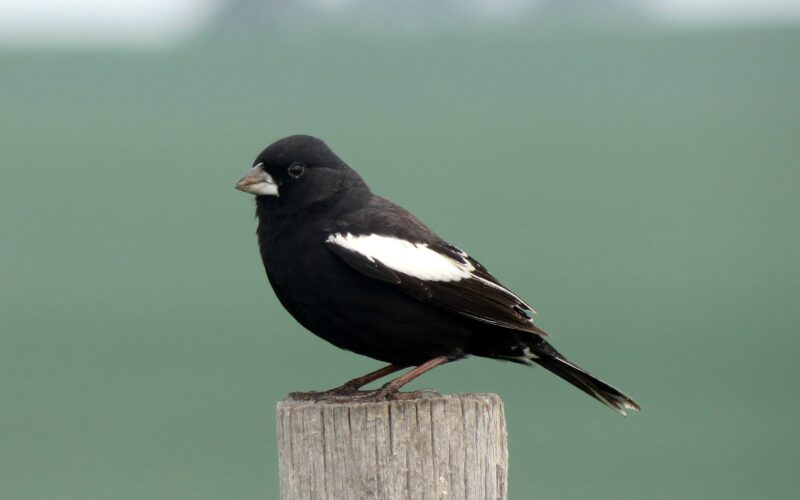
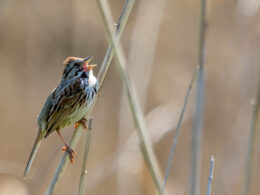
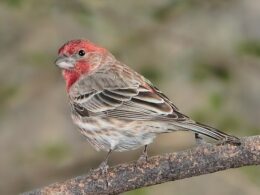
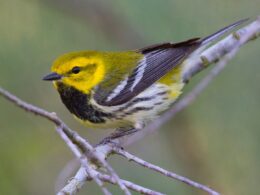
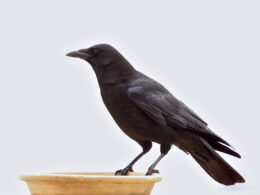
Saw a bird this evening very high up in a tree – looked like a large robin (12 inches beak to tail end), but less plump. Its call was quite loud followed by high pitched "squeaks". I can't figure out what it was.